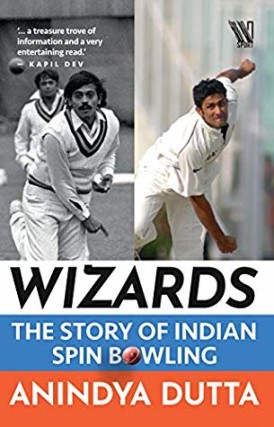Wizards
Martin Chandler |Published: 2019
Pages: 480
Author: Dutta, Anindya
Publisher: Westland
Rating: 4.5 stars

This excellent book from Anindya Dutta is conclusive evidence of two things. The first is that the development of spin bowling in India is a fascinating subject on any level. The second, equally important, is that the best cricket books can be written by those who are not cricket writers, nor indeed career authors or journalists of any sort.
To use his own phrase Dutta is by day an international banker, but even if I hadn’t already known that I would certainly have guessed that he was not a man who was writing for his living. There is absolutely nothing about Dutta’s writing that is pretentious, and there is something about the way that he writes that conveys to his reader that all of the research that was done for the book was primarily for pleasure, and that his conversations with cricketers for the purpose of the book were ones with friends, rather than a quick chat designed to secure a couple of quotes and get another box on the ‘to do’ list ticked.
There have been books about Indian spin bowling before. Biographies and autobiographies of some of the main exponents exist, and in 2000 Ram Guha published the bewitching Spin and Other Turns, although that did not purport to be a comprehensive history. Four years later Partab Ramchand published The Gentle Executioners, a book I have read. Interesting though that was it is not such a good book as Wizards.
And then, only a few weeks ago, we saw the release of Fortune Turners by Adityan Bhushan and Sachin Bajaj. I did wonder if that one had not rather stolen Dutta’s thunder but again it is not quite the same thing, focusing as it does on the great quartet of the 1960s and 1970s and again not seeking to be a full history of the subject. Ownership of Fortune Turners is certainly no reason not to read Wizards, and the opposite is also true.
The Wizards story begins back in 1875 with the birth of Palwankar Baloo who, despite being an untouchable, was able to overcome the caste discrimination of the time by being an orthodox slow left arm bowler of such quality that he was to raise interest in the English counties long before he had ever left India. In the end, as a 36 year old, Baloo did come to England with the first All India side and despite his side being a poor one he was the one top class Indian on show.
The Indians were finally elevated to Test status in 1932 and in the handful of pre war Tests they were able to play their bowling stars were the two pace men, Amar Singh and Mohammad Nissar. There were spin bowlers around, notable amongst them CS Nayudu, a man with a truly horrendous Test record yet a decent First Class one. Dutta’s contribution on Nayudu is a convincing one.
All who pick up Wizards will be aware of the reputation of the famous quartet, Bishan Bedi, Chandra, Venkat and Erapelli Prasanna. Dutta, of course, deals with those great bowlers at some length, but he also dwells on the two previous threesomes who dominated Indian bowling through the 1950s and early 1960. Initially the men concerned were Vinoo Mankad, Ghulam Ahmed and ‘Fergie’ Gupte, and later Bapu Nadkarni, Salim Durani and Chandu Borde.
It is important to point out however that whilst Dutta’s book is more of a series of essays than a continuous narrative he does look at many of the other spinners who, fine bowlers as they may been, didn’t manage to establish themselves. Particularly interesting is the story of Jasu Patel, he of the questionable action but a 9-69 match winning performance against Australia. On the other hand I was a little disappointed not to have learned more about Baloo Gupte, younger brother of Fergie and a fellow leg spinner albeit one with a very poor record in his three Tests.
The section of the book on the quartet is, naturally, a lengthy one and is followed by a look at those whose careers they blocked and, perhaps more interestingly to this reviewer to those who came later and suggested that they too were capable of great things, but who never quite fulfilled their promise. These were men like Shivlal Yadav, Dilip Doshi, Maninder Singh, Laxman Sivaramakrishnan and Narendra Hirwani. Those five were the most notable but there were others as well, filling in the time before Harbajhan Singh and Anil Kumble arrived.
I opened this review by making it clear that I much enjoyed reading Wizards and it follows from that that it is highly recommended. I would particularly refer readers to the passage on the third Test at the Oval in 1971. Back then I had just left primary school and my world was a small one. There was only one Lancastrian on show in the Test and that was Farokh Engineer, so I was an Indian supporter for that game. I sat right through the last two innings of the match but had quite forgotten the tension and anticipation I felt as the Indians first turned the game round and then, not without a few alarms, chased down their target of 173. Dutta’s splendid account brought it all back to me and, I have to say, those few pages alone justify his decision to write the book.






Leave a comment